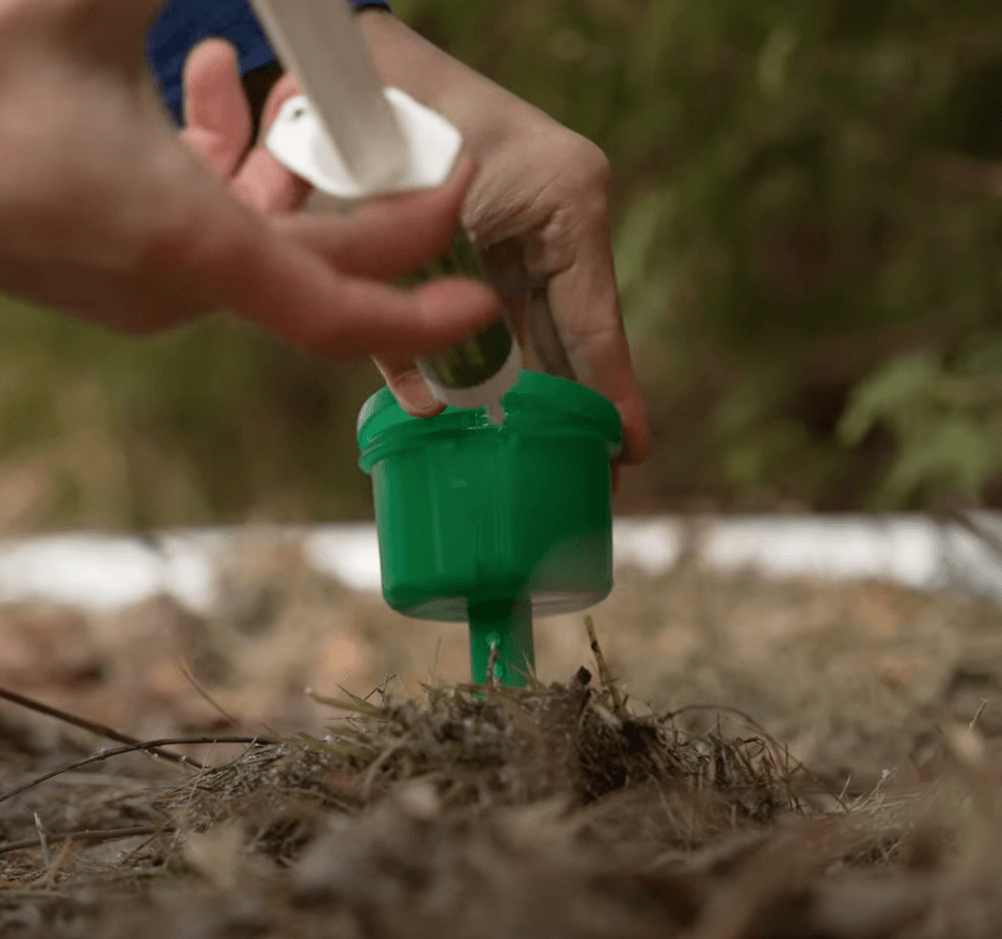
Signs of presence ⌵

General description ⌵

How to get rid of it ⌵

Dangers and damages ⌵
Signs of marmot presence
Marmots, especially in rural or mountainous areas, leave several distinctive signs indicating their presence. One of the most obvious clues is to directly see a marmot, which is a relatively large rodent with a brown coat and often an erect posture. Active during the day, they sometimes stand sentinel near their burrows to watch for predators.
The burrows themselves are another clear sign of marmots: they are often dug into open or rocky terrain, with clearly visible entrances surrounded by freshly dug soil. It is not uncommon to find damaged vegetation around these burrows, as marmots feed heavily on local plants and can ravage entire gardens in a short time. Their feeding sometimes results in the clean cutting of plants, leaving bare stems.
Another audible sign of their presence is their high-pitched whistle, used to communicate and more specifically to alert other marmots in case of danger. This distinctive whistle is often heard even before visually spotting marmots. Finally, their droppings, cylindrical in shape and larger than those of other rodents, are often seen around their burrows or in areas where they are actively feeding.
By observing these signs, it is possible to determine if marmots are occupying a space near a location, particularly in mountainous areas or meadows where they easily find shelter and food.
General description of the marmot
Marmots, members of the genus Marmota , are large rodents related to squirrels. Adapted to cold environments, they have a robust body with short legs and powerful claws, ideal for digging burrows where they live in groups. They are found mainly in North America and Eurasia, often in mountainous regions such as the Rockies and the Alps, but also in grasslands and open areas. Increasingly, we can see them in cities.
These herbivorous animals feed mainly on grasses, flowers and herbs, which they consume abundantly during the summer to accumulate fat reserves for winter hibernation. During this period, which can last up to seven months, the heart rate and breathing of marmots slow down considerably to save energy, a crucial adaptation for their survival in cold environments.
Marmots are also known for their social behavior. In colonies, they communicate with each other by whistles of alarm when a predator is detected, warning their colleagues of danger. Their predators include foxes, eagles, and bears, making them cautious and always ready to quickly retreat into their well-prepared burrows.
Some species, such as the Vancouver Island marmot, are currently endangered and are the subject of conservation programs to address threats from habitat loss and disease in some areas.
Marmots
Groundhogs , those hardy, digging rodents, may seem adorable at first glance. However, when they decide to take up residence under your foundation, in your yard, or near your agricultural facilities, they can cause significant damage. Here’s a step-by-step guide to managing groundhogs and effectively keeping them out of your environment.
Understanding the Enemy: Why Are Groundhogs a Problem?
Groundhogs, also known as woodchucks, are rodents that dig extensive underground tunnel systems. These tunnels can weaken building foundations, damage crops, and even cause accidents if the burrow entrances are not visible. In addition, their appetite for vegetables and flowers makes them feared in vegetable gardens and flowerbeds.
First Steps: Spotting and Identifying Marmot Activity
Before beginning any removal strategy, it is crucial to understand where marmots live and the extent of their activity.
- Identify Tunnels : Look for mounds of dirt near burrow entrances, often located under structures or in grassy areas. These mounds indicate the existence of active tunnels.
- Observe Behavior : Groundhogs are most active in the early morning and late afternoon. Monitor your yard during these times to identify groundhog comings and goings.
Gentle Methods: Deter Groundhogs Without Capturing Them
If you prefer to avoid direct capture, there are several techniques that can deter groundhogs from taking up residence in your home.
- Physical Barriers : Install buried fences around gardens or areas that need to be protected. Make sure the fence is buried at least 30 cm deep, as marmots are expert diggers.
- Groundhog Repellent Plants : Plant herbs or flowers that groundhogs don't like, such as mint, lavender, or thyme. These plants, in addition to being aesthetically pleasing, naturally repel groundhogs.
- Natural Repellents : Use repellents that contain cayenne pepper or ammonia, which you can sprinkle or spray around burrows or garden areas. These substances create an unpleasant olfactory environment for groundhogs. However, if you prefer a scientifically designed repellent from professionals, KONK is an effective product to repel these small mammals.
Active Methods: Capture and Relocate
When gentle techniques are not enough, it may be necessary to capture the marmots to relocate them.
- Capture Cages : Use an appropriately sized cage with a secure closing mechanism such as the Havart cage . Place the cage near the main entrance to the burrow and bait it with fresh vegetables, such as lettuce, carrots or apples.
- Safe Relocation : Once captured, transport the groundhog at least three miles from your property to a wooded or rural area, away from habitation. This reduces the chances of it returning.
Long-Term Prevention: Keeping Groundhogs at Bay
After keeping the groundhogs away, it is crucial to maintain preventative measures to prevent them from returning.
- Blocking Tunnels : Once the marmots have relocated, block the abandoned tunnels with dirt and rocks. This will prevent other marmots from reusing the old burrows.
- Regular Maintenance : Continue to inspect your property for signs of new activity. Regular inspections allow for early action before the problem escalates.
Working with Professionals : For persistent or difficult-to-manage infestations, consider hiring pest control professionals. They can offer more sophisticated solutions tailored to your specific situation.
The dangers and damage caused by marmots
Groundhogs, also known as woodchucks, may seem harmless, but their presence around homes can cause a variety of problems for gardeners and homeowners.
Material damage
Groundhogs dig complex tunnels and gallery systems that can be up to several dozen meters long and go down to depths of 1 to 2 meters. When they dig under foundations, terraces or buildings, they weaken the structure, which can cause cracks, land subsidence and even water infiltration, which damages the foundation. The clods of earth that groundhogs move while digging also create tripping hazards and affect the quality of lawns and gardens.
Damage to crops and gardens
Marmots are herbivores and consume large quantities of vegetables, flowers and garden plants. They often damage vegetable gardens, especially during the summer months when they actively feed to build up reserves before hibernation. They can quickly destroy entire vegetable crops and young plants, which poses problems for farmers and gardeners.
Health risks
While groundhogs do not typically attack humans, they may bite if threatened, especially females with young. They also carry parasites such as ticks and fleas, which can pose an indirect risk of transmitting diseases such as Lyme disease and tularemia. Additionally, although rare, rabies can also be transmitted by groundhogs, making it essential to remain cautious if you must manage them near your property.
In cases of significant damage, it is often necessary to call in professionals for safe management, especially if structures are affected or if marmots continue to return.
With the purchase of a reusable half-mask respirator , get a 10% discount on the 3M vapor cartridge .
Discount code: 6TZJ
de rabais
10%
With the purchase of a Webster Cobweb brush , get a 10% discount on the Webster Cobweb extendable pole .
Discount code: DTSQ
de rabais
30%
With the purchase of a FlowZone backpack sprayer , get a 30% discount on complementary FlowZone products .
Discount code: A29B
de rabais
25%
With the purchase of the Catchmaster Ovi-Planter Ago mosquito trap , get a 25% discount on an Ungava brand mosquito repellent .
Discount code: UH5T
de rabais
25%
With the purchase of the Catchmaster Ovi-Catch Ago mosquito trap, get a 25% discount on an Ungava brand mosquito repellent .
Discount code: UH5T
de rabais
15%
With the purchase of the Envirolights JR fly light trap , get a 15% discount on the Catchmaster Flylight JR sticky panel .
Discount code: ZN7G
Best sellers
-
ANSWER PRO Catch and Release Skunk, Trap for Skunks and Other Large Wild Animals 30.5"x 8"x 9.5"
Regular price $134.99 CADRegular priceUnit price per -
ProPest, Professional Bait for Mice, Rats, and Other Rodents
Regular price $10.99 CADRegular priceUnit price per -
HAVAHART EASY SET, Trap for Large Wild Animals 32''X10''X12''
Regular price $134.99 CADRegular priceUnit price per -
Provoke Professional Mouse Trap Gel Bait 56G/2OZ PR2092
Regular price $9.99 CADRegular priceUnit price per
Wild Animal Blog

Find your solution
Do you have a pest in your home but you don't know what solution to use to get rid of it? Just answer a few questions, and you will get your solution.










